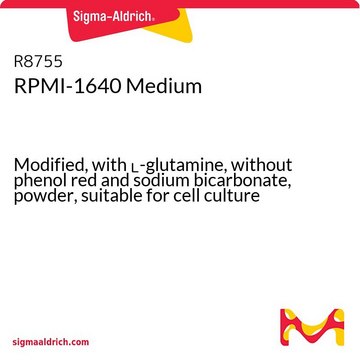R7388
RPMI-1640 Medium
With HEPES, with ʟ-glutamine, without sodium bicarbonate, liquid, sterile-filtered, suitable for cell culture
Synonym(s):
Roswell Park Memorial Institute 1640 medium
About This Item
Recommended Products
Product Name
RPMI-1640 Medium, Modified, with 20 mM HEPES and L-glutamine, without sodium bicarbonate, liquid, sterile-filtered, suitable for cell culture
Quality Level
sterility
sterile-filtered
form
liquid
technique(s)
cell culture | mammalian: suitable
impurities
endotoxin, tested
pH
>7.2
components
HEPES: 20 mM
NaHCO3: no
sodium pyruvate: no
phenol red: yes
L-glutamine: yes
shipped in
ambient
storage temp.
2-8°C
Looking for similar products? Visit Product Comparison Guide
General description
Application
- human immortalized keratinocyte cells and in in vitro transfection assay
- cell lines and human T-cell blasts and to monitor autophagic flux
- peripheral blood mononuclear cells of piglets (PBMCs)
also commonly purchased with this product
Storage Class Code
12 - Non Combustible Liquids
WGK
WGK 1
Flash Point(F)
Not applicable
Flash Point(C)
Not applicable
Choose from one of the most recent versions:
Already Own This Product?
Find documentation for the products that you have recently purchased in the Document Library.
Customers Also Viewed
Our team of scientists has experience in all areas of research including Life Science, Material Science, Chemical Synthesis, Chromatography, Analytical and many others.
Contact Technical Service






